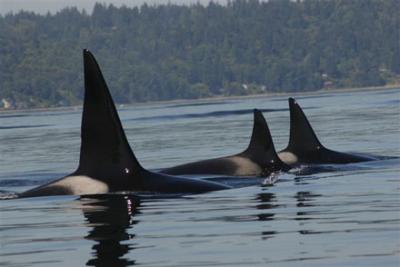
Definition of Dorsal Fin

An orca encounter ranks high on the list of healing events we could hope for on any anniversary of 9/11. We were blessed with one this year, from some old finned friends. Chez VHP was observing the reading of the names at Ground Zero, Shanksville, and the Pentagon when the welcome sighting calls started.
Once again, VHP associate Mark Sears was the only researcher available to obtain ID photos. Among the six Transients Mark photographed off Dilworth on 9/11 were at least three who visited Vashon-Maury in September 2009: T137, T36A, and T36A1. T36A was satellite tagged at the time. You can view her wide-ranging travels at http://cascadiaresearch.org/robin/kwseptember09.htm. Beautiful T137 is recognizable from the distinctive tear on the trailing edge of her dorsal fin.
My eyes popped when I opened Mark’s photos from his August 26 encounter. He captured images of California Transients! These killer whales were in the group that scattered to the north on that day.
The handsome dude in this week’s photo is T132, a.k.a. CA20 and AO10, his additional alpha-numeric IDs from California and Alaska. "Mark, that dorsal is well over six feet," I exclaimed. To paraphrase the corny joke, you look in the dictionary under "killer whale dorsal fin" and you see T132’s picture. From his research boat, Mark had a seal’s-eye view of T132’s massive girth gliding underwater – the biggest bull orca he has ever seen, he commented. Most Transient ages are inexact; CA20’s estimated age is around 43.
Female T134, a.k.a. CA54 and AO12, is beside T132 in Mark’s photo. Her estimated age is around 32. T132 and T134 were once spotted in Glacier Bay, AK, making them quite the long distance swimmers. In my Transient guide, not many whales have IDs from both California and Alaska. As I mentioned last time, Chez VHP is in orca geek overdrive with confirmed IDs of California Transients in Vashon-Maury waters. Since the end of August, both Transient newcomers and repeat visitors graced our Island.
Please support the work of the Vashon Hydrophone Project (VHP): REPORT LOCAL WHALE SIGHTINGS ASAP TO 463-9041. Reporting directly to the VHP sustains an ongoing, accurate dataset of whale sightings for Vashon-Maury and contiguous Central Puget Sound waters, initiated more than 30 years ago by researcher Mark Sears. Call the VHP about seal pups as well as dead, injured, or sick marine mammals on Island beaches. Check for updates at www.Vashonorcas.org and send photos to Orca Annie at Vashonorcas@aol.com.
This is the last opportunity before Odin’s "Killer Whale Matriarchs" carving is auctioned for Vashon Allied Arts on September 24, so I will describe it. Orca societies are matrilineal; thus, several years ago, I asked Odin to create a design for the ladies, so to speak.
Odin’s piece honors matriarchs of Puget Sound’s endangered killer whale population, the Southern Resident Community. The salmon in the body of the lower left whale symbolizes the fish-eating diet of the Southern Residents: J, K, and L Pods. Tlingit and Haida societies are also matrilineal. The raven in the dorsal fin of the top whale alludes to the Haida Raven-finned Killer Whale crest. The eagle in the body of the lower right whale signifies that Killer Whale belongs to the Eagle moiety in the Tlingit matrilineal clan system.
In 2007, Granny (J2), Lummi (K7), and Ocean Sun (L25) were the eldest females in each pod. These were the "ladies" we initially had in mind for the Matriarchs design. 100-ish Granny is now the oldest Southern Resident orca. Ocean Sun is approximately 83. Beloved Lummi, age 98-ish, died in 2008. These precious Pod Elders are culture bearers, embodying Indigenous orca wisdom needed to survive in the Salish Sea, the traditional territory of Southern Residents for thousands of years.
- Login to post comments
